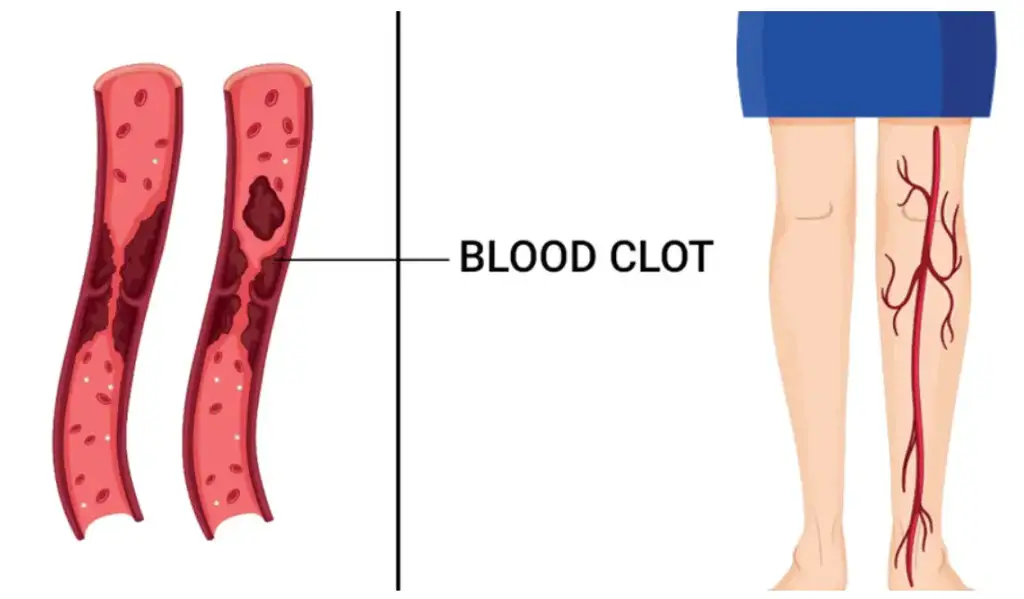Blood clots represent a serious health issue. Therefore, to prevent complications, it is of utter importance to know the symptoms of blood clots and to be able to identify them as soon as possible.

What are blood clots?
Blood clots are clumps of blood that has turned from a liquid to a semisolid state. Clotting represents an essential process that can prevent you from losing blood when you are injured. When a blood clot forms inside the veins, it does not dissolve on its own. It can be a life-threatening situation.
If a blood clot frees and passes from the veins to the heart or lungs, it may get stuck there and prevent proper blood flow. This is a serious health issue that requires immediate medical attention.
Types of blood clots
The circulatory system is made up of arteries and veins, which transport blood throughout the body. Blood clots can be formed in both arteries and veins.
If a blood clot is formed in an artery, it is known as an arterial blood clot. It causes immediate symptoms and requires emergency treatment.
When a blood clot is formed in a vein, it is called a venous clot. Even though these types of blood clots build up slowly, they can still be life-threatening. Deep vein thrombosis is the most serious type of venous blood clot.
Blood clot symptoms
There is no way to understand whether you have blood clots without medical guidance. Nevertheless, if you know the most common risk factors and symptoms, you will know when to seek medical help.
You can have a blood clot without any obvious symptoms. When you have symptoms, some of them are the same as the symptoms of other diseases. Here are some early warning symptoms of blood clots in the arms, legs, lungs, heart, brain, or abdomen.
Pain and swelling in the legs
Pain and swelling in the legs are the most common sign of a blood clot. Clots usually form in the legs and lead to pain and swelling in the veins. You should visit a health expert if you notice this symptom.
Unusual warmth in the legs
The unusual warmth in the legs is another common symptom of blood clotting. You may experience itchiness and soreness in the affected area which cannot be soothed by any therapy or medication. If you experience warmth in the legs you should immediately consult a doctor.
Shortness of breath
Even though it is not a common symptom of blood clots, shortness of breath can be caused by pulmonary embolism. It indicates that the situation is getting worse and requires immediate medical attention.
Pain in the chest
Shortness of breath and pain in the chest are warning signs of pulmonary embolism, which if left untreated, can be fatal. You should never ignore these symptoms. Even though chest pain may indicate that you have problems with the sinuses, it is best to visit a health expert.
Cramps
Although cramps may occur due to a lack of magnesium, they can also be caused by blood clots. If you experience cramps, it may indicate that the blood clots prevent the blood flow to your legs. It is best to consult a doctor as it is a life-threatening situation.
Calf and foot pain
Pain in the foot and calves is an unusual symptom that generally occurs due to deep vein thrombosis. It can be caused when a blood clot forms in the legs and prevent the proper flow of blood to these areas.
Coughs
If you have blood clots, you may also experience unusual coughs. It means that a smaller blood clot has formed in the lungs and is causing trouble. If this symptom is accompanied by coughing blood or mucus, you should immediately consult a doctor.
Diagnosing blood clots by common symptoms is difficult. Almost 50% of the people with deep vein thrombosis have no symptoms. Blood clots have fatal consequences if these symptoms are ignored. Therefore, it is best to call your doctor if you think you have a blood clot. Get the symptoms checked by a health expert before it is late.